 What ACT Math Formulas Should Students Know and Tips To Memorize Them?
What ACT Math Formulas Should Students Know and Tips To Memorize Them?
ACT Math section comprises 60 five-multi-choice questions that students should respond to within 60 minutes. The questions are drawn from six topic areas covered up to 11th grade. They include Pre-algebra, intermediate algebra, elementary algebra, coordinate geometry, trigonometry, and plane geometry.
Here are the topics and skills covered on the Math ACT test.
Algebra
The section comprises 14 questions and tests the student on decimals, whole numbers, fractions, ratio, positive integer powers, integers, square roots, percentage, and proportion. Other topics tested include one variable, linear equations, absolute value, multiples and factors, median, mean, mode, data interpretation, and counting problems and probability.
Intermediate Algebra
This part comprises nine questions testing the student in inequalities, absolute value, quadratic formula, systems of equation, rational and radical expressions, functions, quadratic inequalities, polynomials, matrices, and complex numbers.
Elementary Algebra
There will be around ten questions in the area touching on polynomials, variables, factoring, integer exponents, square roots, linear inequalities, and quadratic equations.
Plane Geometry
You will have 14 questions touching on plane figures such as rectangles, parallelograms, triangles, trapezoids, and circles. Some questions test knowledge on perpendicular lines, rotations, 3-D geometry, area, perimeter, logical reasoning, volume, translations, and reflections.
Coordinate Geometry
There will around nine questions from the area testing on the graph of points, number line graphs, circles, polynomials, lines, curves, midpoint formula, conics, transformations, distance formula, equations, and graph relationships, slope, and properties of perpendicular and parallel lines.
In the section, Trigonometry will find four questions on trigonometric functions, equations and identities, right triangle trigonometric ratios, and trigonometric functions modeling.
List of ACT Math Formulas
Here is a list of 13 ACT math formulas you need to know for the ACT test:
- Arithmetic Mean
- Probability
- Quadratic Equation
- Distance Formula
- Slope Formula
- Slope Intercept Formula
- Midpoint Formula
- Area of a Triangle
- Pythagorean Theorem
- Area of Rectangle and Perimeter
- Volume of Cuboid
- Area of a Circle
- Trigonometric Formulas
Arithmetic Mean
This is the same as average, and it is the sum of all items divided by the number of items. For instance, calculating the average of values, you divided the sum by the number of values

Probability Formula
Probability is used in calculating the possibility of the number of times something will occur in a set of possible results. It is a representation of the chances of something happening. A probability of 1 means there is a particular something that will happen, but a possibility of 0 means something won’t happen.

Quadratic Equation
The formula expressed as:
x = −b ± √b²-4ac/2a
It is used to determine the x-intercepts of a parabolic or quadratic equation.
Distance Formula
The formula is used when calculating the distance between two points on a coordinate plane. The formula is expressed as:
d=√(x₁ – x₂)² + (y₁ – y₂)²
Slope Formula
The slope is a measure of line changes expressed as the Y-axis change divide by the change on the X-axis (rise/run).
For instance, if you have point A (X1, Y1) and B(X2, Y2), then you can calculate slope as:
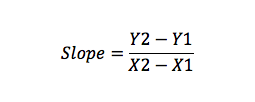
Slope Intercept Formula
The slope-intercept formula is a line equation expressed as Y=MX+b in which:
- M stands for the line’s slope, while b is the y-intercept where the y-intercept point crosses the y axis.
- If the line will pass through the origin, then the y-intercept is zero, and the equation will be expressed as Y=MX.
Midpoint Formula
This is a formula that finds the midpoint of a line. For instance, if you have two points, A(X1, Y1) and B(X2, Y2), then the midpoint will be:

Area of a Triangle
The formula expressed as ½ (base x height) is used to calculate the total area enclosed in a triangle.
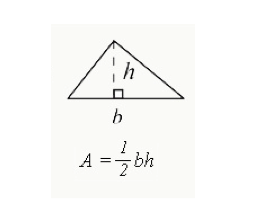
- b= the base of the triangle (the edge of one side)
- h=the height of a triangle. The height for a right-angle triangle will be the side with a 90-degree angle. For other triangles, the height will drop down the interior of the triangle, as shown above.
Pythagorean Theorem
Pythagoras theorem is crucial when calculating a right-angled triangle’s unknown side when two sides are known. The formula is expressed as a2+b2=c2. The sum of two shorter sides is equal to the sum of the longer side.

Area of Rectangle and Perimeter
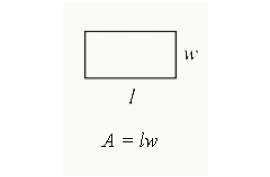
To find a rectangle’s area, you multiply the length by the width. It is the total area enclosed in a rectangle.
Area = Length x Width
On the other hand, a rectangle’s perimeter is the distance around it.
Perimeter = (L+W+L+W) simplified as 2(L+W)
Volume of Cuboid
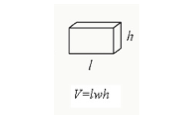
You can calculate a cuboid’s volume by multiplying its length, width, and height of the cuboid.
Area of a Circle
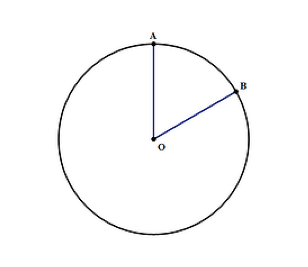
A circle’s area can be found using the formula πr2 where:
- π is a constant that is written as 3.14, which is important to remember if you will not have a calculator during the test
- r-is the circle’s radius, like in the diagram above. It is the distance from O to the edge of the circle at point A or B
similarly, the distance around the circle is referred to as the circumference. It is calculated as:
Circumference of the circle = πD or 2πr
Where:
- D, which is the diameter is twice the circle’s radius. It is the line that divides the circle into two half touching two ends of a circle.
Trigonometric Formulas Sine (SOH), Cosine (CAH), Tangent (TOA)
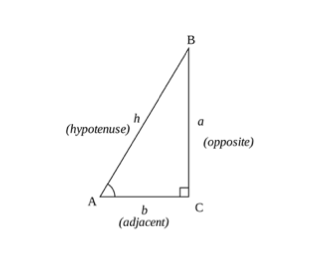
Trigonometric calculations can be summed by basic concepts of a triangle using the sine, cosine, and tangent rules (SOHCAHTOA). You can calculate the cosine, sine, or tangent of an angle using a triangle’s sides.
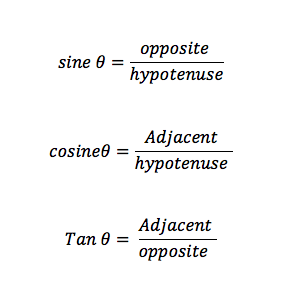
Where:
- Opposite side- is the triangle’s side that is opposite to the angle ( )
- Adjacent side- is the side that is nearest to the angle but not the longest side.
- The hypotenuse is the triangle’s longest side.
Tips for Memorizing ACT Math Formulas and Equations
To memorize the formulas during the ACT exam, it is important to familiarize yourself early by reading in the topic areas specified for the Math test.
You can also practice by attempting as many problems as possible to master the formula.
Using different channels like saying the formulas louder or writing them on charts and sticking them in your room can help you remember the formulas.

